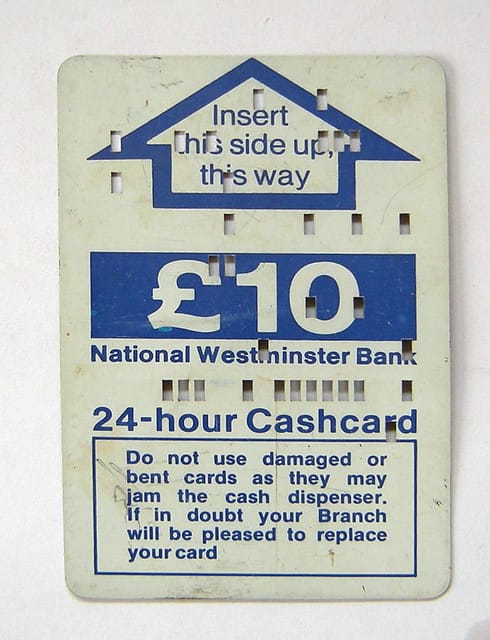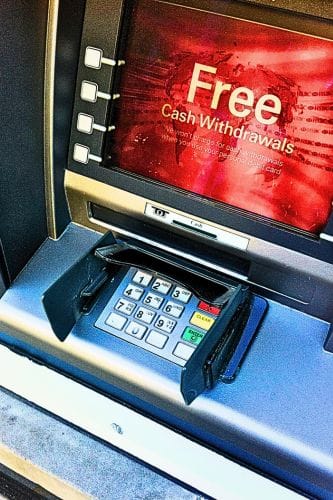ATM Chronology
This is not a detailed log of installation dates or technical breakthroughs, all that is documented elsewhere. Instead, this is about exploring the evolution of ATMs in terms of the services they offered to customers, and what that might tell us about their future.
1960s – The Pioneering Era
The first ATM was installed in Barclays Bank, Enfield, in 1967. It was a single-function machine that dispensed a fixed amount of cash, with the withdrawal being initiated by a bank-issued ATM card.
The Cash Cards were the same size as the cards we are familiar with today, but they were perforated, like computer punch cards. The ATMs were essentially mechanical, with electronics providing the crypto functions to support the 6-digit PIN [1].
The bank would issue their customers with a supply of Cash Cards – I seem to remember my dad having three of them in his wallet – and when they were used, the ATM would verify the PIN and exchange the card for £10 in notes. I don’t remember specifically but I would think the ATM would be dispensing £1 notes and maybe 10s notes, depending on the construction of the vending mechanism, because £10 in 1967 is nearly £170 today, and we all know the difficulty we have today buying a newspaper with a £50 note!
The ATM withdrawal was processed on the next banking day; the transaction was processed as a cheque and once completed, the card was posted back to the cardholder.
In 1967, the ATM was very much a new technology, allowing customers access to cash outside banking hours and at weekends. At this time, the ATM facilities provide by the bank would have served solely as a service differentiator; the ATMs installed were not cheap, and their operation inevitably introduced additional manual procedures for the branch staff.
[1] Acknowledging that the Guardian, reflecting on the 1960’s, implies that the PIN was 10-digits long.

1970s – The Foundational Era
The ATMs of the 1960s were primarily viewed as experimental, but as machine technology developed – along with the introduction and standardisation of the magnetic stripe card – so too did their acceptance and availability … and the business case.
The provision of ATMs remained a service differentiator until full access to the ATM network was available to all in the 1990s; ATMs are now seen as one of the costs of being a bank rather than as a customer selling point.
Towards the end of the 1970s, the concept of the ATM had become established, and access to cash outside banking hours had become the norm.
I remember the ATMs at the banks serving the University of Warwick: the Nat West machine had a rubber roller display, a bit like the destination indicators on the front of buses; Lloyds Bank had an IBM machine with a single line dot matrix display that you had to peer at through a narrow, horizontal slot; The Midland Bank had an ATM with a CRT display, which was monochrome and prone to screen burn-in.
The services offered by the ATMs of the time were equally limited, we had Cash Withdrawals, with transaction and daily limits, and Balance Enquiries.
1980s – The Developmental Era
The introduction of in-branch ATMs relieved the pressure on branch staff and therefore had the effect of reducing the employee overhead. Similarly, the provision of external, “hole-in-the-wall” devices reduced the demand for cashiers during banking hours but in addition, provided customers with access to their cash outside of banking hours.
The ATM business case further developed in the 1980s and was largely based on the cost benefits of reducing the number of cashiers – whose primary function was to dispense cash.
During the Developmental Era, ATMs that began as essentially single-function devices, primarily deployed to dispense cash and replace cashiers, were enhanced to include Mini-statements, PIN change services, and in some cases, deposit facilities.
Early in the Development Era, services provided by ATMs were fragmented and usually available only to cardholders of the banks and building societies operating the ATMs. This situation began to change towards the middle of the decade with the LINK network being established in 1985. The common network approach allowed the cost of delivering ATM services to be shared across the service providers, to the benefit of the cardholders. At this point, service differentiation shifted from the competitive advantage of providing ATMs only to cardholding customers, to the differentiation provided by a cardholding customer being able to use any ATM displaying the Link logo.
The concept of the ATM network was established with Link, and then along came MATRIX, and MINT followed in 1989 – there were others.
Somewhere around 1988, the Link network operated around 3000 ATMs. The Halifax Building Society at the time, also operated around 3000 ATMs. The Halifax Building Society (where I worked supporting the ATMs) joined Link and doubled the size of the Link network overnight. Mike Whitehouse, Operations Director at the time, jovially considered the Link network to be a handy back up should one of the Halifax ATMs be unavailable.
1990s – The Convergence Era
This was the time when the ATM networks were joining together, and I remember working on the amalgamation of Link and MATRIX, ensuring that MATRIX transactions were accepted and then routed correctly.
During the 1990s and recognising the potential for extending the cashier utility provided by the ATMs, the range of features provided by ATMs expanded.
Deposits (Envelope)
Cash and cheques, along with the appropriate paying in slips, could be deposited in ATMs using ATM cards to access the service and sealed envelopes to make the deposit.
The envelope hoppers were emptied at the start of each banking day, the envelopes were then opened and the deposits confirmed as accurate – these tasks were always performed by a two-person team, to reduce the risk of error or fraud. If the deposit matched the paying in slip and the paying in slip matched that of the original transaction, the cash and cheques were cleared (applying the same timelines as payments over the counter).
Funds Transfer (own accounts)
Cardholders could transfer funds from one account to another, using the ATM screens, buttons and workflow, as long as they were the owners of both accounts.
PIN Change
The ability to change PIN hasn’t always been around, and it certainly wasn’t around in 1967 as the PIN was encoded in the little perforations. I don’t remember being given the option of PIN change when I was issued with my first NatWest Servicecard but PIN Change must have been available soon after as I have used the same PIN to this day – on all my cards (except for the ones with 12-digit PINS!)
Bill Payments
It was possible, though not widespread, for cardholders to be able to pay utility bills from the ATM. A screen would pop up showing all the available Bill Payment recipients and the cardholder would choose who to pay and how much to pay.
Implementation Considerations
Deposits in envelopes are not difficult to implement physically, and messaging to support deposits across the network could just be a fairly straightforward repurpose of the withdrawal request. However, the potential for the additional remedial workload created by errors and disputes, especially when extended across the network between competitive organisations, makes the whole business case unworkable.
Funds Transfer and Bill Payments would also struggle due to the increased demand for information exchange. Whilst it is one thing to hang a special facility off an ATM connected to the same host as that supporting the cardholder account, it is quite something else to pass that information across a switch. I worked at Funds Transfer Sharing (one of the founder members of Link) in the 1990s and we built a cross-network service to support Bill Payments and Funds Transfer – it didn’t catch on!
Even when PIN Change became available, it didn’t become available across network switches until later, and when the Halifax Building Society joined Visa in 1989, it was with withdrawals and balances.
So, whilst the number of features expanded, the availability of those features was restricted as the network message infrastructure at the time was only built to support cash withdrawals, and in some cases, account balances.
The takeaway here is that whilst it is possible to grow what today we might call ATM aps, their implementation and acceptance is dependent on the ability of the network to manage the exchange of information and on the appetite for the services provided – ultimately, an ATM is a cash dispenser!
2000s – The Expansion Era
The first years of the decade concluded the Convergence Era, and the ATM world saw the dawn of generally interoperability.
Then came the expansion of ATM services, which looked like turning ATMs into external mini branches, by taking away button-pressing activities from cashiers and developing additional services that were not related to existing cashier operations.
Cash Recycling
There are devices that can accept, validate and count cash under the control of cashier operators, there are ATMs capable of doing this too.
Funds Transfer (within and across banks)
Some of the services and facilities that were introduced in the 1990s were still being developed, alongside services in the non-ATM world, like Faster payments introduced in 2008.
Mobile Top-ups
Initially, pre-paid mobile phones were topped up using vouchers issued by the mobile phone operators and sold through existing retail channels. As pre-pay mobile phone usage increased (which hadn’t been anticipated) there was a growing demand for alternative means of top-up – generally from the telcos as they were paying up to 40% commission on voucher sales.
Account to account top-up services were developed alongside the existing voucher model, allowing pre-pay mobile phone users to top up using internet banking.
The ATM Funds Transfer process was adapted to sit behind a modified ATM withdrawal transaction, allowing cash to be transferred from a current account to a mobile pre-pay account. This service was introduced by Link in October 2002.
It has subsequently been withdrawn from service as a direct consequence of the proliferation of mobile banking apps rendering it obsolete.
Statement and Cheque Book requests
This is an obvious service extension for ATMs but is limited to services that banking customers need and are unable to request elsewhere. Statements and Cheque Books were obvious candidates, but they are not now – I can see all my transactions on my banking app, I can download a PDF of any bank statement … and what’s a cheque book?
Advertising and Cross Selling
I don’t suppose the potential for either advertising or cross selling was viable for the one-line dot matrix display that had to be read through an adjustable horizontal slot, or for a scrolling black rubber display with static white writing, but that changed once ATMs were fitted with colour screens. Advertising looks so much better on a colour screen.
One of the challenges with advertising and cross selling is time, especially when there is a queue at the ATM. The essence of an ATM is withdrawal throughput, whilst the essence of advertising and cross selling is engagement, and engagement takes time.
Chip and PIN
The introduction of EMV didn’t change the headline functionality of the ATM. The technology was different, the cryptography was new to cards, but the services remained unchanged.
2010s – The Digital Integration Era
There are a lot of things that can be done with an interactive colour screen and an array of buttons, and many of these have been tried. Some represent simply an alternative way of doing something that is already well established, and others deliver a range of alternative services that complement (or maybe not) the existing range of traditional ATM services.
Cardless Transactions
These should not be confused with contactless transactions. Cardless transactions are driven by QR codes, mobile apps and possibly, one-time passwords (OTP).
These types of transaction bypass established ATM workflows, which require a card (contact or contactless) to initiate the transaction, but they don’t deliver anything substantially different – the ATM still dispenses cash.
Dynamic Currency Conversion
A standard ATM withdrawal sees the cardholder account operating in the same currency as the ATM, and the messaging reflects this. Interregional ATM withdrawals see a different cardholder account currency to that supported by the ATM, in which case, the currency is converted by the switch. Dynamic Currency Conversion (DCC) allows for a more complex approach to multi-currency cash withdrawals, provided by additional services integrated into the process.
DCC does not extend the services delivered by the ATM, only the way in which they are delivered.
Contactless Transactions
Contactless transactions are an alternative physical implementation of the standard EMV processes, where the ATM service is initiated using the contactless interface rather than the contact interface. Apart from an alternative approach to calculating the cryptogram, caused by the logic of the contactless interaction, the two transactions are identical.
Contactless transactions enhance the usability of the ATM but not the functionality.
2020s – The Declining Era
Globally, ATM deployment is still growing.
But … cash usage in the Westen World is in decline, and it took a big hit during the Covid crisis, from which it hasn’t recovered.
And … many, if not all the value-added services that can be provided by ATMs can now be delivered via a mobile app.
So … the key service delivered by the ATM is the cash withdrawal, which you might say is obvious, and which was also the sole function of the ATM installed in the wall at Barclays, Enfield in 1967.
2030s – The Post-Cash Era
Will we be looking back at the glory days of notes, coins and ATM deployment with nostalgia, or will be be living in a post-cash era?
The business case for ATMs rests on them being used, particularly in the case of convenience ATMs, and the interchange that comes from the card issuer following that use … and it is reasonably clear that if the number of withdrawals (and balance enquiries) falls, then the ATM business case fades.
It is worth noting that whilst the use of ATM withdrawal services might drop, the value of the service to the individual end user – those using the ATMs to withdraw cash – doesn’t!
Cheques, once a common site in retail, postal and over the counter banking transactions, remain operational but in vastly reduced numbers. As a result, the cost of processing individual cheques has risen, and this is reflected in the charges levied for depositing a cheque over the counter.
We can also make a comparison to Open Banking. We know that whilst the data side of Open Banking can benefit the consumer, it does not directly benefit the “bank” supplying it. The “bank” providing the data incurs the overhead of providing the data, but the data is meant to be provided for free. In the EU and UK, this is recognised and the provision of data within Open Banking is required through legislation.
The data sharing provided by Open Banking is of benefit to the consumer of financial services, but there are no commercial drivers for the providers of this data, and the financial service providers claim they would not be able to operate their services if the data wasn’t free.
Are there parallels to be drawn between Open Banking and the provision of ATMs? As a society, we probably need to hang on to the ability to spend cash, and this implies that we then need to hang on to the ability to withdraw cash.
If the fall in cash usage drops below the ATM viability threshold, will we need legislation to maintain our access to cash?
Explore the Future of Payments
The global payment ecosystems continues to evolve with technologies like AI, tokenisation, and real-time payments.
Stay ahead of the game by diving deeper into the world of payment processing.
Have questions or need expert insights? Contact us.







